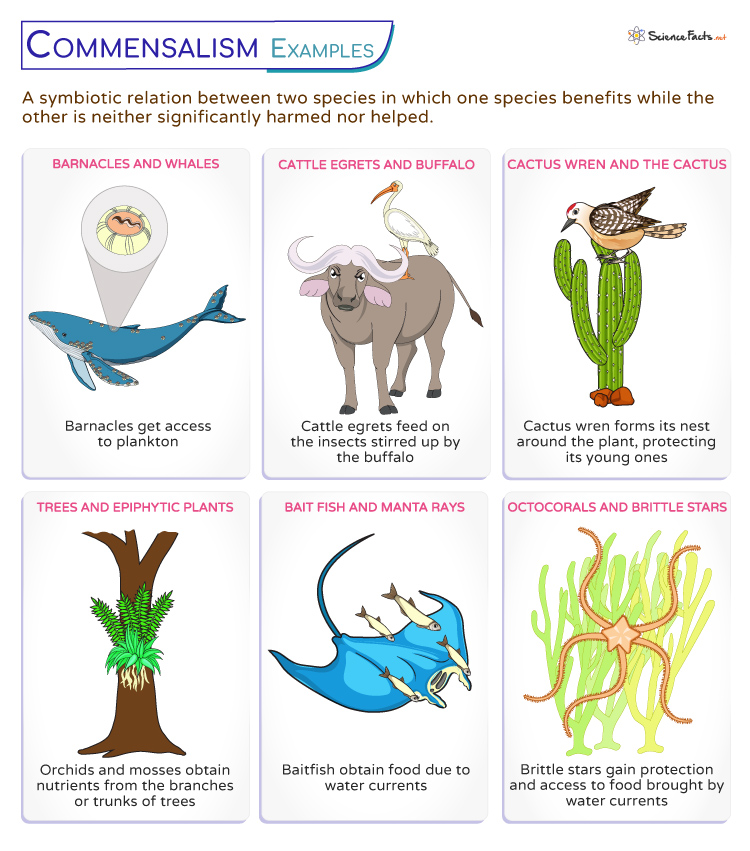Commensalism
Commensalism is a symbiotic relationship between two species, where one species benefits while the other is neither helped nor significantly harmed. In other words, it is a win-neutral situation. The best example of commensalism is sea barnacles attached to the skin of whales.
Unlike parasitism, where one organism benefits at the expense of the other, and mutualism, where both organisms benefit, commensalism involves an unequal partnership. The organism benefiting is the commensal, while the other organism is the host.
The term ‘commensalism’ was coined by Pierre-Joseph van Beneden in 1876, obtained from the Latin word ‘commensalis,’ which means ‘sharing a table.’
Types of Commensalism
A commensal relationship is of three types based on the nature of the interaction between the partners:
- Inquilinism: In this type, one organism lives within the habitat of another without causing any harm. Some examples are the nesting of birds in tree branches and epiphytic plants growing on trees.
- Phoresy: It involves one organism hitching a ride on another for transportation. The hitchhiker gains mobility while the host remains unaffected. An example is mites attaching themselves to larger insects.
- Metabiosis: Here, one species unintentionally provides habitat for another species while carrying out its daily activities.
- Microbial Commensalism: Some organisms form commensal relationships with microorganisms living on or within them. These microorganisms often provide benefits like aiding digestion or protecting against harmful pathogens.
Examples of Commensalism in Nature
It is difficult to prove that one of the partners is not benefiting from the other while in a relationship. However, plenty of such examples exist from terrestrial, desert, and marine ecosystems.
Brittle stars gain protection and access to food particles brought by water currents
Some common examples of commensalism in nature are:
Barnacles and Whales
Barnacles are marine organisms that attach to the skin of whales. They benefit from the whale’s movement through water, which provides them access to plankton-rich areas. The whale, in turn, remains unaffected by the barnacles’ presence.
Cattle Egrets and Grazing Animals
Cattle egrets are birds that follow large grazing animals like cows or buffalo. As the animals move through the grass, they disturb insects, which the egrets feed on. The animals are undisturbed by the birds’ presence.
Trees and Epiphytic Plants
Epiphytic plants, such as orchids and mosses, often develop on the branches or trunks of trees. These plants obtain nutrients from rainwater and debris without harming the host tree. The host tree is not significantly affected by the presence of these epiphytes.
Cactus Wren and the Cactus
In the desert, the cactus wren benefits from the cactus by forming its nest around the plant, thus protecting its baby. The cactus is not affected or damaged by the relation.
Pseudoscorpions and Other Insects
Pseudoscorpions are tiny arachnids that often hitch a ride on larger insects, such as flies or beetles. These pseudoscorpions gain transportation to new feeding grounds and potential prey, while the bigger insects are unaffected by their presence.
Bait Fish and Manta Rays
Small fishes and even plankton often gather around the large bodies of manta rays. As the manta rays swim, they stir up water and create currents that bring food closer to the surface. Thus, due to the manta rays’ movements, the bait fish feed on plankton attracted by the water currents.
Octocorals and Brittle Stars
Octocorals, also known as soft corals, provide a habitat for brittle stars. These small, mobile echinoderms attach themselves to the branches of the octocorals. While the brittle stars gain protection and access to food particles brought by water currents, their presence does not significantly affect the octocorals.
All the above examples show commensalism in other animals except humans. In humans, the microbiota of our skin and the gastrointestinal tract are in a commensal relationship.
How Mutualism and Parasitism Differ from Commensalism
The table below shows the differences between commensalism, mutualism, and parasitism.
| Basis | Commensalism | Mutualism | Parasitism |
|---|---|---|---|
| 1. Partners Benefit or Harmed | One species benefits while the other is neither benefitted nor harmed. | It is a cooperative relationship between two species where both organisms benefit from the interaction. | One species (the parasite) is benefitted, and the other (the host) is harmed. |
| 2. Obligatory or Non-obligatory Relationship | It is a non-obligatory relationship. | It is an obligatory relationship. | It can be an obligatory or non-obligatory relationship. |
| 3. Positive or Negative Association | It is a positive association. | It is a positive association. | It is a negative association. |
| 4. Example | Oxpeckers and grazing animals | Bees and flowering plants | Ticks and mammals |
-
References
Article was last reviewed on Tuesday, September 26, 2023




